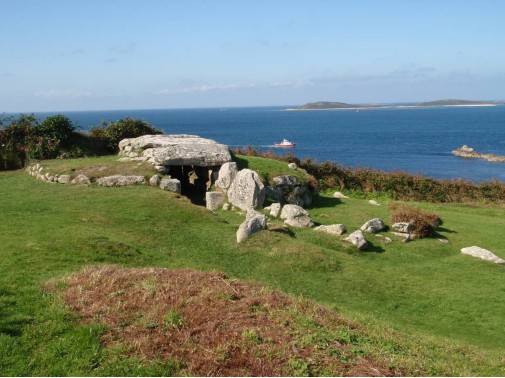Bronze Age people thrived despite dramatic loss of land due to sea-level rise, new study suggests
Posted on 4 November 2020
 A Bronze Age entrance grave (‘Bant’s Carn’) on St Mary’s, Isles of Scilly. Photo credit: © Cornwall Archaeological Unit, Cornwall Council
A Bronze Age entrance grave (‘Bant’s Carn’) on St Mary’s, Isles of Scilly. Photo credit: © Cornwall Archaeological Unit, Cornwall Council
The study, involving researchers from the University of York, looked at how the Isles of Scilly have changed over the last 12,000 years, and how local populations responded to sea-level rise.
The research shows that in the last 8000 years the sea level has risen by about 12 metres, transforming the landmass from one big island into several medium size ones, and eventually into the more than 140 small islands which make up the Isles today.
Adapted
Rather than fleeing, the archaeological evidence suggests that around 5,000 years ago, when sea-level rise was claiming land at a rapid rate, Bronze Age populations adapted and flourished as they exploited the resources on newly created salt marshes and mudflats for hunting, fishing and gathering.
The findings suggest that rising sea levels will can affect coasts and human societies in complex and unpredictable ways, the authors of the study say.
Co-author of the study, Professor Roland Gehrels from the Department of Environment and Geography at the University of York, said: “During the Bronze Age the rate of land loss was so rapid, that it would have been very noticeable to the locals living there at the time. But the consequences for people were not all negative and new resources meant that many of them flourished.
“The traditional view of sea-level rise is that the impact on prehistoric coastal communities was usually catastrophic and forced mass migrations. However, our findings suggest these ideas must be re-assessed in the light of what happened on Scilly.
“There may be some lessons for small island nations today – many of which are on the front line of climate change and sea-level rise. Although it is perhaps unlikely that sea-level rise will create new resources, human responses could be less predictable than the simplistic models of flooding, erosion and subsequent migration. Scilly teaches us that adaptive responses to climate change and sea-level rise depend on many geographical, societal and cultural factors.”
Rapid land loss
The study, led by the University of Exeter in partnership with Cornwall Archaeological Unit and 15 other institutes, found that changes in both land area and human cultures happened at variable rates, and often out of step with the prevailing rate of sea-level rise.
The period of rapid land loss on Scilly happened at a time of slowing sea-level rise – because lots of Scilly’s land at that point was relatively flat and close to sea level.
The study found that between 5000 and 4,000 years ago, land was being lost at a rate of 10,000 m2 per year, which is equivalent to a large international rugby stadium. However, about half of this land was turning into intertidal habitats, which may have been able to support the coastal communities.
With climate change now driving rapid sea-level rise, the team says the effects will not always be as simple as a forced human retreat from coasts.
Human responses
Lead author Dr Robert Barnett, of the University of Exeter, said: “When we’re thinking about future sea-level rise, we need to consider the complexity of the systems involved, in terms of both the physical geography and the human response. The speed at which land disappears is not only a function of sea-level rise, it depends on specific local geography, landforms and geology.
“Human responses are likely to be equally localised. For example, communities may have powerful reasons for refusing to abandon a particular place.”
The new research extends and enhances data collected by the Lyonesse Project (2009 to 2013), a study of the historic coastal and marine environment of the Isles of Scilly. The researchers developed a new 12,000-year sea-level curve for the Isles of Scilly, and looked at this alongside new landscape, vegetation and human population reconstructions created from pollen and charcoal data and archaeological evidence gathered.
Explore more news

New butterfly species created 200,000 years ago by two species interbreeding
Thursday 18 April 2024

Children in the North at greater risk of entering care
Wednesday 17 April 2024

Boreal forest and tundra regions worst hit over next 500 years of climate change, study shows
Monday 8 April 2024

Researchers developing ultra-sensitive blood test with potential to revolutionise diagnosis of Alzheimer’s
Thursday 4 April 2024

Attitudes to being an adult are shifting as traditional milestones become out of reach, new study finds
Wednesday 27 March 2024
Media enquiries
About this research
The research was funded by a grant from English Heritage (now Historic England) to the Cornwall Council Historic Environment Service (now Cornwall Archaeological Unit). Outputs from the original project (The Lyonesse project: A study of the historic coastal and marine environment of the Isles of Scilly (2016)) are also available from the Cornwall Archaeological Unit.
Non-linear landscape and cultural response to sea-level rise is published in the journal Science Advances.
Explore more of our research.
